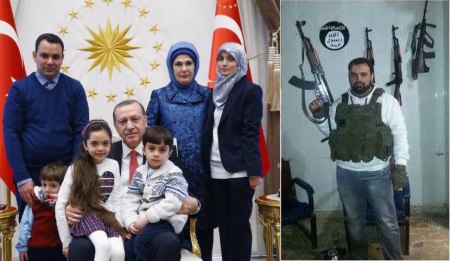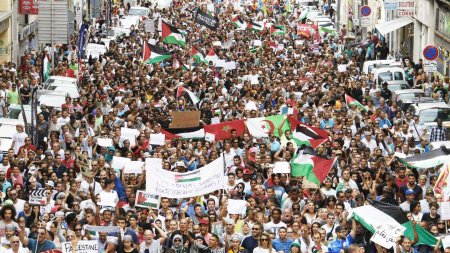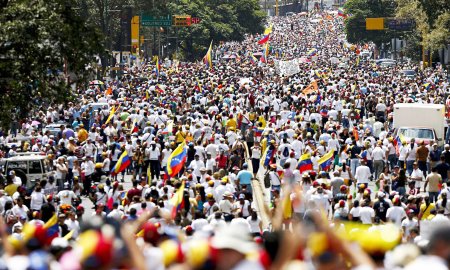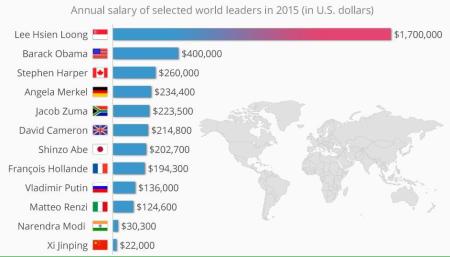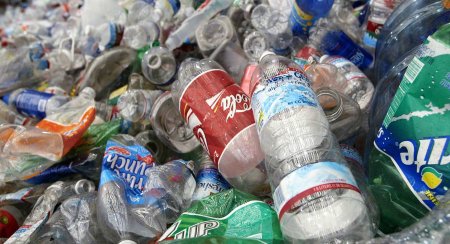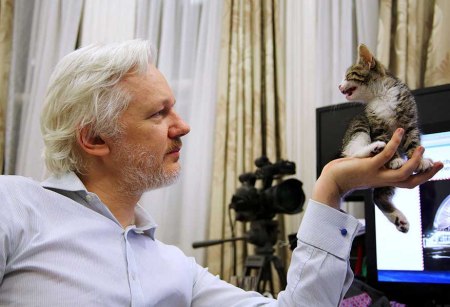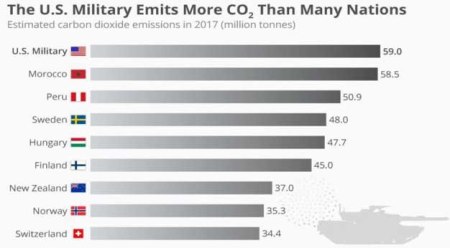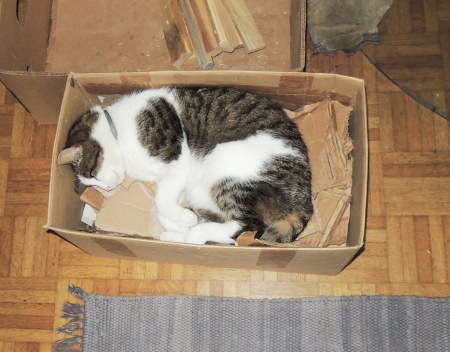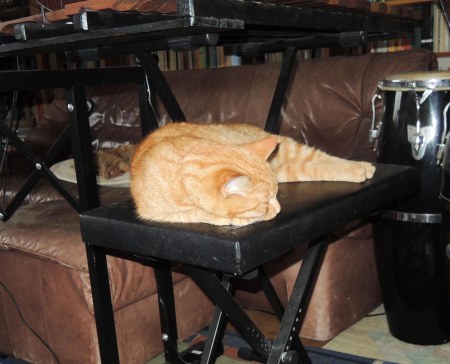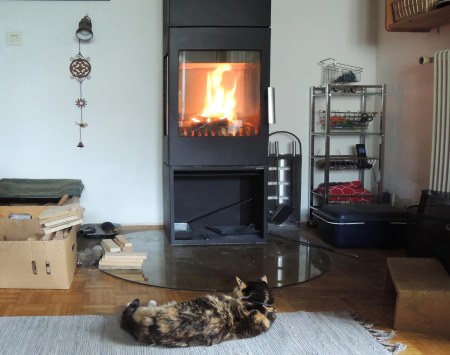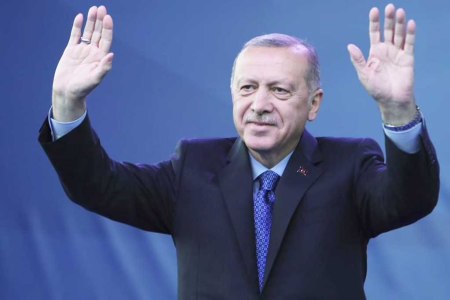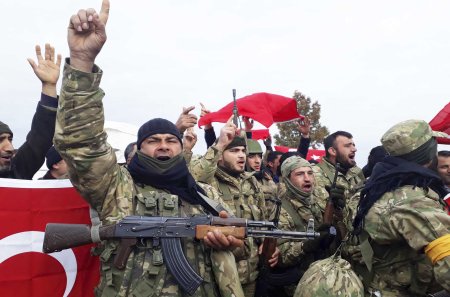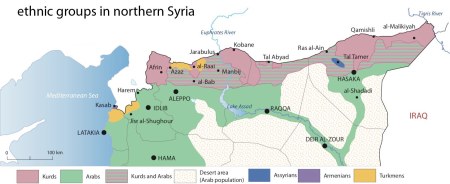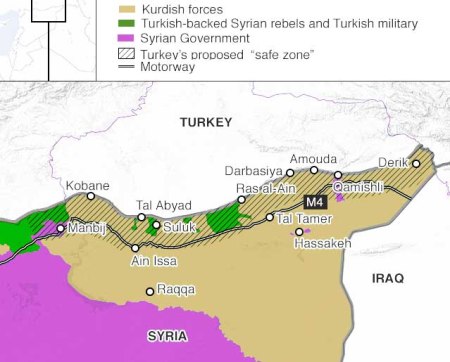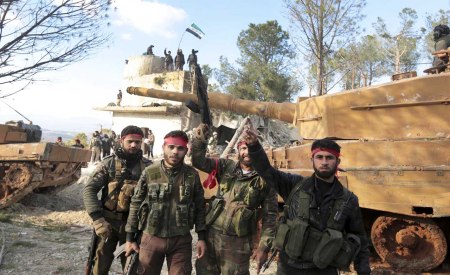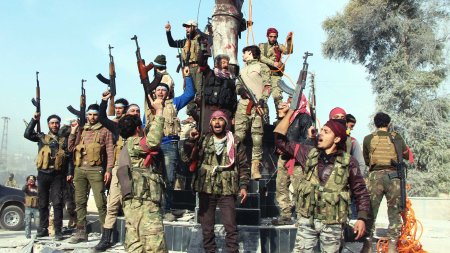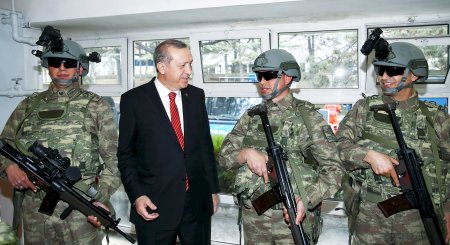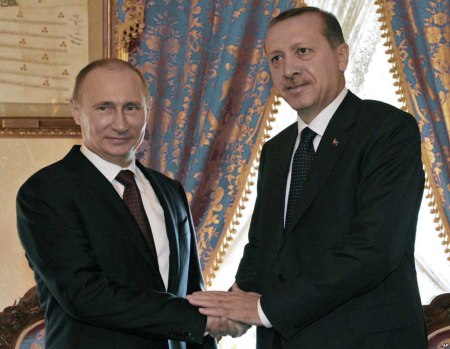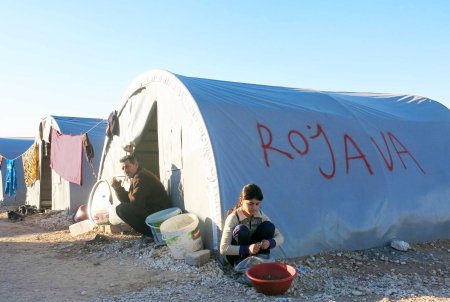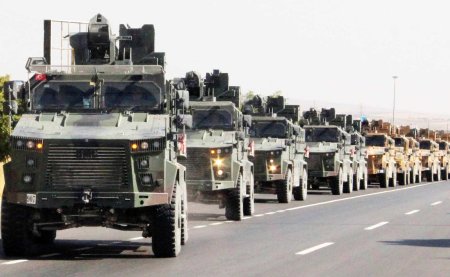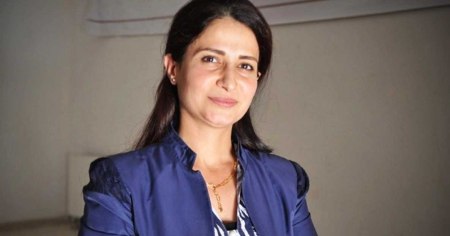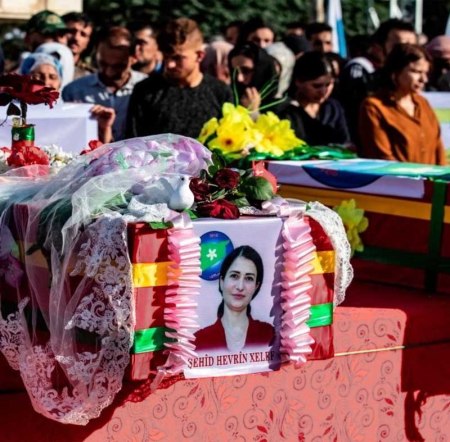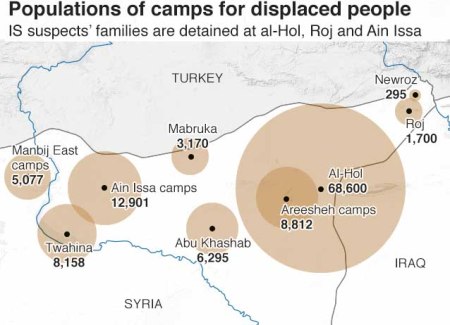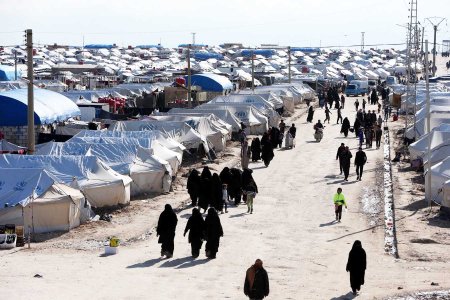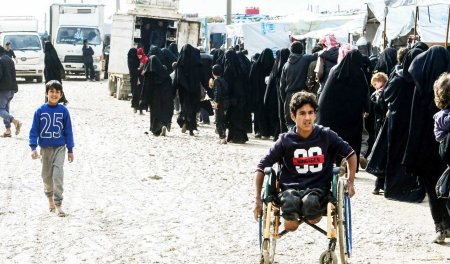At the moment it seems, that the Turkish invasion into Syria is turning into all out war. Can Vladimir Putin or somebody else stop Recep Tayyip Erdogan?
Congresswoman and presidential candidate Tulsi Gabbard on Twitter: “Erdogan has been helping ISIS/AQ for years. He has denied this but is now openly using militias of “former” ISIS/AQ terrorists, exposing him for what he really is: a radical Islamist megalomaniac who wants to establish a caliphate with himself as the Caliph — the supreme ruler. “
Erdogan, who again tries playing all sides (USA, Russia, Iran) at the same time, makes new threats: “Kobane needs to be cleared of militants and come under our control.” (Since the heroic stand against the Islamic State in 2014, Kobane is the spiritual capital of Rojava).
Right now it looks like Putin sells out Syria just as easily as Trump sold out the Kurds. Russia will do just about all it can to avoid direct conflict with Turkey and will offer Erdogan heavy concessions due to the destabilizing effect his actions have on NATO. The West is restricted by how hard it can push Turkey because Erdogan has made it quite clear he’ll turn towards China and Russia for both economic support and defense contracts. Erdogan seems very confident in the fact that nothing will unite NATO and Russia against him, so he will continue trying to get as much concessions as possible from both sides.
US troops moved to Tall Tamr countryside right at the Turkish Syrian frontline under air force protection. US troops also came back to Sarrin base near Kobane.
There are now Kurdish, Syrian, Russian, and Turkish Islamist troops intermingled in northern Syria and the situation has become very complicated. Turkey wants more Syrian territory, the Islamists want to kill and loot, the USA wants the oil (or at least prevent, that Syria accesses its oil), Russia wants to become the main power broker in the region, the Kurds want their autonomous statelet, Syria want’s to restore sovereignty over all its territory (which should, if something like international law would exist, be also the main goal of the “international community”).
At the moment no one can say how this story ends, maybe we know more in a few days. The Turkish aggression will be discussed comprehensively in the next blogposts.
What else is going on? A lot, for sure.
People around the world are bitter, disillusioned, and desperate.
Political leaders are despised, accused of incompetence, nepotism, corruption, and theft.
There are protests and demonstrations of unprecedented size, there is discontent and social unrest in dozens of countries. This is surely an enormous story, maybe even the biggest story at the moment, and the lack of coverage in mainstream media is telling. The people who own or control mass media prefer to have no reports about the protests because social discontent and unrest are contagious.
Police and military use teargas, rubber bullets, even life ammunition, while protesters vandalize, burn, and loot. Many people die, public and private property is randomly destroyed, the cities become a war zone.
Is there indeed an increase in discontent?
Does social cohesion disappear?
Is the social contract unraveling?
Is there a class war?
Does social cohesion disappear?
Is the social contract unraveling?
Is there a class war?
Are protesters claims and accusations justified?
Are the grievances solely the result of bad governance?
Is there repression, exploitation, discrimination, and abuse of power?
Are the grievances solely the result of bad governance?
Is there repression, exploitation, discrimination, and abuse of power?
Are the protesters demands realistic?
Are the resources available to meet these demands?
What are the chances, that things change for the better?
Do the protesters, dissenters, critics have a plan or a shared vision?
Why don’t people organize, take things in their own hands, and enact change themselves instead of calling for it?
Are the resources available to meet these demands?
What are the chances, that things change for the better?
Do the protesters, dissenters, critics have a plan or a shared vision?
Why don’t people organize, take things in their own hands, and enact change themselves instead of calling for it?
Central demands are: Affordable food, fuel, housing; functioning public services; social justice and equality; jobs and improved working conditions; ending social, ethnic, or religious discrimination.
Global ecological changes (climate, pollution, resource depletion) and globalized economies, societies, and cultures mean that the protest movements are connected, yet there are nevertheless significant differences and each movement has to be evaluated with the checklist of the above listed questions.
Possible causes:
Glaring income inequality plays a role in most protests. People realize that they will never get rich no matter how hard they work, while others, who are born rich, get even richer without having to work at all (the rentier class). Rising social tensions in a society based on individualism, egoism, and competition, resource scarcity (potable water, food), and unrealistic expectations raised by media fairytales of success and affluence also increases discontent. Our hectic urban life, with a never diminishing cacophony of man-made unnatural sounds and always switched on electric lights can make people feel uncomfortable and itchy.
Nonviolent mass movements once tended to be surprisingly effective in removing incumbent leaders from power or achieving territorial independence, even when they experienced severe repression from the government. However, in the last years the success rates of nonviolent campaigns have declined by about 20 percent, because authoritarian leaders have begun to develop and systematize sophisticated techniques to undermine and thwart nonviolent activists.
Methods of authoritarian adaption against nonviolent resistance:
Using institutional violence against dissidents (Assange, Manning, Kings Bay Plowshares 7)
Tightly controlling the media, silencing critical journalists
Misinforming, confusing, deceiving, and brainwashing people
Planting under cover police and agents provocateurs
Infiltrating and sabotaging protest movements
Co-opting or bribing union leaders, influencers, celebrities
Administratively and financially obstructing civil society groups
Passing laws and decrees which criminalize protests
Using pro-establishment paramilitary groups
Tightly controlling the media, silencing critical journalists
Misinforming, confusing, deceiving, and brainwashing people
Planting under cover police and agents provocateurs
Infiltrating and sabotaging protest movements
Co-opting or bribing union leaders, influencers, celebrities
Administratively and financially obstructing civil society groups
Passing laws and decrees which criminalize protests
Using pro-establishment paramilitary groups
There is a theory that violent fractions (black blocs, black-clad anarchists, casseurs) of per se nonviolent protest movements make the movements less attractive to the broad public and also deter defections of security forces.
The capacities of protestors are found in their leverage and in their abilities to coordinate and maintain large-scale collective action. Leverage comes from the power resources that a group can draw on to inflict costs on an autocratic regime in order to extract concessions (like for instance more civil rights and increased social welfare. Leverage can come from the ability to impose economic costs on the regime through strikes, boycotts, obstruction, or sabotage.
Other sources of leverage include access to weapons, manpower with relevant training, and militant ideologies that motivate recruits. Urban middle classes score high on leverage because urban professionals occupy inflection points in the economy, such as finance. Industrial workers can also hold a strategic stranglehold over the economy, being able to organize strikes targeting key sources of revenue for the regime.
Protest hotspots:
Haiti
In the year prior to September, security forces killed 77 people. Since then protests intensified and least 20 more died.
Haiti is the poorest country in the Western Hemisphere. Food availability is uncertain for 60 percent of the people. Shortages of oil and other basic supplies are generating almost total paralysis of daily life (Venezuelan oil shipments are blocked by the USA). Haitis teachers strike and about three million students do not attend schools since mid-September. There are no schools and no governmental activity.”
Bolivia
Crowds burned the offices of the electoral body in the southern cities of Sucre and Potosi, and protesters set fire to ballots from the presidential elections. Groups of Morales’ supporters and opponents clashed in a number of places, including the capital of La Paz.
Chile
Unrest started with the looting of 40 supermarkets and other businesses. Five people died after looters torched a garment factory near Santiago, three people died after a supermarket in Santiago was set alight. Soldiers fired life rounds at demonstrators, bringing the death toll to at least 20. 300 people are wounded, 4,000 arrested.
President Sebastian Pinera, a conservative billionaire, declaring a state of emergency, deployed the military and enforced nighttime curfews across Santiago and other major cities. The military and police used tear gas, water cannons, and life ammunition. 10,500 police and soldiers have been deployed. This looks like Pinochet 2.
Most banks, schools, and shops remain closed. There’s simmering discontent in the country’s universities and schools over lack of resources and underfunding. Dockworkers and copper miners are striking.
1 million protesters were in the streets of Santiagio on October 25.
Ecuador
After ten people were killed, about 1,400 injured, and 1,100 arrested, an agreement was reached between the Lenin Moreno government and protesters against a controversial Decree 883 which applied neoliberal austerity policies of the IMF.
Argentina
In September thousands of protesters took to the streets of Buenos Aires among a food crisis. The economic collapse has left a third of Argentina’s population in poverty.
President-elect Alberto Fernandez and vice-president Cristina Fernandez de Kirchner now face the impossible task to improve peoples lives and at the same time fend off IMF and international investors, who call for more austerity.
Mexico
Mexicans are demonstrating against corruption and drug cartel violence.
Lebanon
A million protesters in Lebanon flooded the streets, waving the national flag and chanted “revolution” or “the people demand the fall of the regime.” Prime Minister Hariri has resigned. Banks are closed.
Ending rampant corruption is a central demand of the protestors, who say the country’s leaders have used their positions to enrich themselves for decades through favorable deals and kickbacks. There are chronic electricity and water shortages.
The USA has mounted pressure on Lebanon’s financial system in recent months as part of its economic campaign against Iran, leading to a rush to change accounts from Lebanese currency into US dollars or to transfer money out of the country.
Algeria
Algeria’s Hirak protest movement is active since spring.
The interim government appears to be ramping up repression, including extended pre-hearing detentions and holding protesters in inhumane conditions. 110 people are currently detained across the country
Egypt
Thousands protested in Cairo, Alexandria, Damietta, and other cities. The Sisi regime quelled the protests with tear gas, rubber bullets, and live ammunition. 4300 people have been arrested. The exact death toll is not known.
Iraq
“The people want the fall of the regime,” demonstrators were heard chanting as they marched through Baghdad, part of a protest movement targeting corruption, failing public services, and rising unemployment.
More than 300 people have been killed since the start of the protests, mostly protesters but also security personal and member of Iranian militias. 100 died and nearly 1,000 were wounded in Karbala in one day.
Ethiopia
67 protesters were killed, 170 arrested. Prime Minister Abiy Ahmed, this year’s winner of the Nobel Peace Prize, was in Russia when the protests broke out. Ahmed has denounced the killing of protesters and described the current situation as “an attempt to provoke an ethnic and religious crisis.”
Guinea
Protesters descended on police checkpoints and burnt tires, chanting “It will not pass,” in response to President Alpha Condé’s attempt to alter the constitution and run for a third term.
Hong Kong
20 percent live below the poverty line and it could get worse as Hong Kong might be heading for a recession after months of violent protests, marked by vandalism and police brutality.
Spain Catalonia
A general strike and mass marches in Barcelona followed the jailing of Catalonian independence leaders.
France
In addition to the weekly Giles Jaunes (Yellow Vest) gatherings, thousands of firefighters marched for more funding and better working conditions. The Giles Jaunes movement is still taking to the streets but its activity is less impressive than at the beginning.
Britain
Hundreds of thousands demonstrated in London in a huge outpouring of concern at the economic and social impact of Brexit, with the UK set to leave the European Union (EU) on October 31. The People’s Vote and the Independent newspaper’s “Final Say” campaign claimed, that up to one million people participated.
Netherlands
Farmers blocked the country’s motorways with their tractors after the government introduced lower nitrogen emission limits.
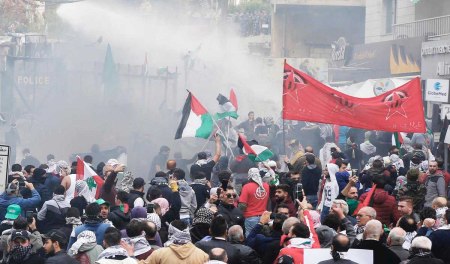 Though the respective governments of Lebanon, Chile, Ecuador and Hong Kong have all canceled the measures that angered the public in the first place, protests have only intensified. This presents decision-makers with a dilemma: Signal weakness by doing nothing, or inflame tensions further with a police crackdown?
Though the respective governments of Lebanon, Chile, Ecuador and Hong Kong have all canceled the measures that angered the public in the first place, protests have only intensified. This presents decision-makers with a dilemma: Signal weakness by doing nothing, or inflame tensions further with a police crackdown?
How to solve the climate crisis:
– Stop weapons production, end militarism and war.
– End the economic system which requires infinite growth on a finite planet.
– Ban any form of rentier income.
– Ban all advertising
– Let people get more relaxed and less busy.
– End corporate influence in politics, culture, and education.
– End patents, intellectual property, and copyright.
– Kill the propaganda engine known as the mainstream media.
– End the economic system which requires infinite growth on a finite planet.
– Ban any form of rentier income.
– Ban all advertising
– Let people get more relaxed and less busy.
– End corporate influence in politics, culture, and education.
– End patents, intellectual property, and copyright.
– Kill the propaganda engine known as the mainstream media.
(Based of a text by Caitlin Johnstone)
Feline news:
http://hatchingcatnyc.com/2019/10/02/republican-tammany-cats-elections/
https://www.vice.com/en_us/article/a35nze/i-gave-my-cat-a-fitness-tracker-and-the-results-were-worrying
https://www.asiatimes.com/2019/10/article/feline-solution-to-a-parking-ticket-problem/
http://hatchingcatnyc.com/2019/10/20/bedford-cats-milk-part1/
http://hatchingcatnyc.com/2019/10/27/lefferts-cats-bergen-street-part2/
https://www.bbc.com/future/article/20191024-why-do-we-think-cats-are-unfriendly Not well written nor especially informative but also not completely useless. The reader decides.
https://www.dailymail.co.uk/news/article-7621119/Foreign-Office-cat-Palmerston-deaths-door.html We all have to go one day. Goodbye, my friend.
https://www.vice.com/en_us/article/a35nze/i-gave-my-cat-a-fitness-tracker-and-the-results-were-worrying
https://www.asiatimes.com/2019/10/article/feline-solution-to-a-parking-ticket-problem/
http://hatchingcatnyc.com/2019/10/20/bedford-cats-milk-part1/
http://hatchingcatnyc.com/2019/10/27/lefferts-cats-bergen-street-part2/
https://www.bbc.com/future/article/20191024-why-do-we-think-cats-are-unfriendly Not well written nor especially informative but also not completely useless. The reader decides.
https://www.dailymail.co.uk/news/article-7621119/Foreign-Office-cat-Palmerston-deaths-door.html We all have to go one day. Goodbye, my friend.
Environmental news:
200 million people around the world live in some 350 cities that are dealing with temperatures higher than 35 degrees Celsius. More people die from heat than from all other extreme weather phenomena combined.
https://www.thenation.com/article/climate-summit-greta/ The ugly (in the eyes of mass media) autistic child tells the even uglier movers and shakers of the world, how nefarious, irresponsible, despicable, and disgusting they are.
http://www.informationclearinghouse.info/52330.htm
https://www.apnews.com/4e12b39584dc4f8eaf6796b9582ada56 Zimbabwe’s capital Harare has run out of water.
https://www.reuters.com/article/australia-drought/rpt-drought-hit-australian-towns-prepare-for-unimaginable-water-crisis-idUSL3N26K0DC
https://www.spiegel.de/international/globalsocieties/zambia-drought-increases-risk-of-famine-a-1288843.html
https://e360.yale.edu/features/why-chinas-renewable-energy-transition-is-losing-momentum Energy consumption needs to go down, everything else is window dressing.
https://www.localfutures.org/resist-globally-renew-locally/ Wise words in an unwise and silly world.
http://wise.nautil.us/feature/447/is-the-world-making-you-sick Important!
https://www.spiegel.de/international/world/cities-seek-protection-in-the-age-of-climate-change-a-1288750.html
https://earther.gizmodo.com/bolvias-forest-fires-have-left-more-than-2-million-anim-1838492071?utm
https://www.asiatimes.com/2019/10/article/fires-and-haze-a-big-health-risk-to-indonesians/ https://truthout.org/articles/global-wildfires-are-raging-leaving-long-lasting-damage
https://dgrnewsservice.org/civilization/ecocide/habitat-loss/trees-felled-in-india-and-nepal-amid-protests/
https://e360.yale.edu/features/amazon-watch-what-happens-when-the-forest-disappears
https://www.counterpunch.org/2019/09/27/climate-change-and-technology/There is no other solution than reducing industrial activity and resource consumption.
https://countercurrents.org/2019/09/the-climate-action-summit-fiasco The biggest polluters (USA, China, EU, India, Brazil, Saudi Arabia) just shrug. Why scale back consumption just to benefit future generations?
https://www.independent.co.uk/environment/shipping-pollution-sea-open-loop-scrubber-carbon-dioxide-environment-a9123181.html Wicked shipowners destroy marine life and wicked politicians let it happen.
https://www.globalresearch.ca/global-warming-and-the-ozone-layer-whats-more-dangerous-co2-or-nuclear-war/5690216 Long read, but informative.
https://meta.eeb.org/2019/10/01/save-money-cut-emissions-eu-pulls-plug-on-wasteful-unrepairable-products/ Industry will sabotage this plan at every step, but let’s try nevertheless.
https://meta.eeb.org/2019/10/24/thousands-of-dead-fish-wash-up-in-protected-spanish-lagoon/
https://www.hakaimagazine.com/news/nine-years-on-the-deepwater-horizons-well-is-a-hellscape/
https://www.greenpeace.org/usa/wp-content/uploads/2019/09/report-throwing-away-the-future-false-solutions-plastic-pollution-2019.pdf
https://theintercept.com/2019/10/23/coca-cola-plastic-waste-pollution/
http://www.informationclearinghouse.info/52330.htm
https://www.apnews.com/4e12b39584dc4f8eaf6796b9582ada56 Zimbabwe’s capital Harare has run out of water.
https://www.reuters.com/article/australia-drought/rpt-drought-hit-australian-towns-prepare-for-unimaginable-water-crisis-idUSL3N26K0DC
https://www.spiegel.de/international/globalsocieties/zambia-drought-increases-risk-of-famine-a-1288843.html
https://e360.yale.edu/features/why-chinas-renewable-energy-transition-is-losing-momentum Energy consumption needs to go down, everything else is window dressing.
https://www.localfutures.org/resist-globally-renew-locally/ Wise words in an unwise and silly world.
http://wise.nautil.us/feature/447/is-the-world-making-you-sick Important!
https://www.spiegel.de/international/world/cities-seek-protection-in-the-age-of-climate-change-a-1288750.html
https://earther.gizmodo.com/bolvias-forest-fires-have-left-more-than-2-million-anim-1838492071?utm
https://www.asiatimes.com/2019/10/article/fires-and-haze-a-big-health-risk-to-indonesians/ https://truthout.org/articles/global-wildfires-are-raging-leaving-long-lasting-damage
https://dgrnewsservice.org/civilization/ecocide/habitat-loss/trees-felled-in-india-and-nepal-amid-protests/
https://e360.yale.edu/features/amazon-watch-what-happens-when-the-forest-disappears
https://www.counterpunch.org/2019/09/27/climate-change-and-technology/There is no other solution than reducing industrial activity and resource consumption.
https://countercurrents.org/2019/09/the-climate-action-summit-fiasco The biggest polluters (USA, China, EU, India, Brazil, Saudi Arabia) just shrug. Why scale back consumption just to benefit future generations?
https://www.independent.co.uk/environment/shipping-pollution-sea-open-loop-scrubber-carbon-dioxide-environment-a9123181.html Wicked shipowners destroy marine life and wicked politicians let it happen.
https://www.globalresearch.ca/global-warming-and-the-ozone-layer-whats-more-dangerous-co2-or-nuclear-war/5690216 Long read, but informative.
https://meta.eeb.org/2019/10/01/save-money-cut-emissions-eu-pulls-plug-on-wasteful-unrepairable-products/ Industry will sabotage this plan at every step, but let’s try nevertheless.
https://meta.eeb.org/2019/10/24/thousands-of-dead-fish-wash-up-in-protected-spanish-lagoon/
https://www.hakaimagazine.com/news/nine-years-on-the-deepwater-horizons-well-is-a-hellscape/
https://www.greenpeace.org/usa/wp-content/uploads/2019/09/report-throwing-away-the-future-false-solutions-plastic-pollution-2019.pdf
https://theintercept.com/2019/10/23/coca-cola-plastic-waste-pollution/
https://www.theatlantic.com/magazine/archive/2019/11/the-end-of-silence/598366/
https://www.futurity.org/green-buying-millennials-materialism-2180022/
https://www.bbc.com/news/science-environment-49997755 Lifestyle changes are necessary indeed, but investment policies of corporations and governments at all levels have to change too.
https://www.nationalgeographic.com/science/2019/10/billions-face-water-food-insecurity/
https://news.mongabay.com/2019/10/witnessing-extinction-in-the-flames-as-the-amazon-burns-for-agribusiness/
https://www.asiatimes.com/2019/10/article/water-war-risk-rising-on-the-mekong/
https://www.theguardian.com/global-development/2019/oct/15/failing-food-system-means-millions-of-children-are-malnourished-or-overweight-unicef
https://www.wsws.org/en/articles/2019/10/16/wate-o16.html Australian towns running out of water.
https://www.reuters.com/article/us-australia-drought-widerimage/thirst-turns-to-anger-as-australias-mighty-river-runs-dry-idUSKBN1X22TT
https://www.theguardian.com/environment/2019/oct/29/australias-beloved-native-birds-are-disappearing-and-the-cause-is-clear
https://meta.eeb.org/2019/10/17/nature-groups-call-for-dialogue-as-dutch-farmers-protests-turn-violent/ Farmers are unhappy about new measures to reduce ammonia, nitrogen oxide, and nitrous oxide pollution from farms.
https://truthout.org/articles/we-cant-solve-the-plastics-crisis-with-other-disposables
https://www.localfutures.org/disaster-localization-a-constructive-response-to-climate-chaos/ An important preparation for withstanding future climate catastrophes, which was not addressed in this article: We have to increase personal contacts and join or build a local web of friendships, neighborhood help, volunteering, activist groups, farmers markets, barter groups, cooperatives, and various forms of informal local economy.
Especially in Western consumer societies people get more isolated and lonely. Social contacts are either drowned out by information overload from electronic media (TV, YouTube, news channels) or passed through social media (Facebook, Twitter, Instagram) where they can be distorted, censored, or blocked.
The increased social isolation makes people more vulnerable to brain washing, exploitation, and abuse. It makes people more dependent on corporate services (supermarkets, e-commerce like Amazon and eBay). It diminishes the chance of coordinated grass root actions against natures destruction.
https://www.futurity.org/green-buying-millennials-materialism-2180022/
https://www.bbc.com/news/science-environment-49997755 Lifestyle changes are necessary indeed, but investment policies of corporations and governments at all levels have to change too.
https://www.nationalgeographic.com/science/2019/10/billions-face-water-food-insecurity/
https://news.mongabay.com/2019/10/witnessing-extinction-in-the-flames-as-the-amazon-burns-for-agribusiness/
https://www.asiatimes.com/2019/10/article/water-war-risk-rising-on-the-mekong/
https://www.theguardian.com/global-development/2019/oct/15/failing-food-system-means-millions-of-children-are-malnourished-or-overweight-unicef
https://www.wsws.org/en/articles/2019/10/16/wate-o16.html Australian towns running out of water.
https://www.reuters.com/article/us-australia-drought-widerimage/thirst-turns-to-anger-as-australias-mighty-river-runs-dry-idUSKBN1X22TT
https://www.theguardian.com/environment/2019/oct/29/australias-beloved-native-birds-are-disappearing-and-the-cause-is-clear
https://meta.eeb.org/2019/10/17/nature-groups-call-for-dialogue-as-dutch-farmers-protests-turn-violent/ Farmers are unhappy about new measures to reduce ammonia, nitrogen oxide, and nitrous oxide pollution from farms.
https://truthout.org/articles/we-cant-solve-the-plastics-crisis-with-other-disposables
https://www.localfutures.org/disaster-localization-a-constructive-response-to-climate-chaos/ An important preparation for withstanding future climate catastrophes, which was not addressed in this article: We have to increase personal contacts and join or build a local web of friendships, neighborhood help, volunteering, activist groups, farmers markets, barter groups, cooperatives, and various forms of informal local economy.
Especially in Western consumer societies people get more isolated and lonely. Social contacts are either drowned out by information overload from electronic media (TV, YouTube, news channels) or passed through social media (Facebook, Twitter, Instagram) where they can be distorted, censored, or blocked.
The increased social isolation makes people more vulnerable to brain washing, exploitation, and abuse. It makes people more dependent on corporate services (supermarkets, e-commerce like Amazon and eBay). It diminishes the chance of coordinated grass root actions against natures destruction.
Economic news:
The US federal budget deficit is 984 US$ in 2019 and will most likely surpass one trillion in 2020.
https://www.newstatesman.com/politics/economy/2019/09/rentier-capitalism-does-not-come-reset-button
https://journal-neo.org/2019/09/25/climate-and-the-money-trail/ Enlightened “disaster capitalism.” Saving the world by privatizing and monetizing common goods, including air, water, and soil.
https://aeon.co/essays/what-does-small-business-really-contribute-to-economic-growth Astute observations, but no alternative perspective offered.
https://www.project-syndicate.org/commentary/financial-globalization-neoliberalism-discredited-by-arvind-subramanian-and-dani-rodrik-2019-09
https://www.cnbc.com/2019/09/27/russias-bid-to-ditch-the-us-dollar-is-slowly-working-but-obstacles-remain.html
https://journal-neo.org/2019/10/08/will-fed-make-trump-a-new-herbert-hoover/
https://evonomics.com/an-evolutionary-theory-of-resource-distribution/
https://truthout.org/articles/converting-businesses-to-cooperatives-just-got-easier
https://www.rt.com/business/471608-russia-writes-off-african-debt
https://www.opendemocracy.net/en/oureconomy/our-response-next-crisis-must-tackle-consumerism/
https://evonomics.com/the-sacrificial-rites-of-capitalism-we-dont-talk-about/Recommended reading.
https://journal-neo.org/2019/09/25/climate-and-the-money-trail/ Enlightened “disaster capitalism.” Saving the world by privatizing and monetizing common goods, including air, water, and soil.
https://aeon.co/essays/what-does-small-business-really-contribute-to-economic-growth Astute observations, but no alternative perspective offered.
https://www.project-syndicate.org/commentary/financial-globalization-neoliberalism-discredited-by-arvind-subramanian-and-dani-rodrik-2019-09
https://www.cnbc.com/2019/09/27/russias-bid-to-ditch-the-us-dollar-is-slowly-working-but-obstacles-remain.html
https://journal-neo.org/2019/10/08/will-fed-make-trump-a-new-herbert-hoover/
https://evonomics.com/an-evolutionary-theory-of-resource-distribution/
https://truthout.org/articles/converting-businesses-to-cooperatives-just-got-easier
https://www.rt.com/business/471608-russia-writes-off-african-debt
https://www.opendemocracy.net/en/oureconomy/our-response-next-crisis-must-tackle-consumerism/
https://evonomics.com/the-sacrificial-rites-of-capitalism-we-dont-talk-about/Recommended reading.
Media and technology news:
Many believe that mainstream media journalists just tell outright lies all the time, but that’s not how it usually works. What journalists do is selectively omit inconvenient facts, disproportionately amplify convenient facts, and uncritically rely on dubious government assertions. Basically they only tell the truth when it’s convenient, and when it’s inconvenient they are silent. One can get away with this method a lot easier.
Most western news headlines about foreign conflicts and uprisings can simply be reduced to either “Something advantageous happened to the US-imperial power alliance, and that’s good” or “Something disadvantageous happened to the US-imperial power alliance, and that’s bad“. It’s basically the same as watching a group of sports fans comment on the behavior of their favorite team. Except instead of fans it’s paid propagandists, and instead of a game it’s a low level and slow-moving third world war.
https://www.opendemocracy.net/en/oureconomy/how-facial-recognition-surveillance-capitalism-streets/ If everyone carries a smartphone, which reliably reports where one has been at any time in ones life, why do they need facial recognition? To sort out the “bad apples,” who have left their phones at home or even don’t own one?
https://digitstodollars.com/2019/09/26/the-heat-death-of-5g/ 5G, a really hot topic.
https://www.globalresearch.ca/telcos-losing-battle-impose-5g/5691065
https://caitlinjohnstone.com/2019/10/01/twitter-suspends-accounts-for-propaganda-has-literal-propagandist-as-high-level-executive/
https://www.rt.com/op-ed/469854-ukraine-disinformation-war-wapo/
https://www.theguardian.com/environment/2019/oct/11/google-contributions-climate-change-deniers
https://www.asiatimes.com/2019/10/article/chinas-big-brother-is-watching-your-every-move/
https://www.ibtimes.com/dangerous-push-more-technology-schools-2849550
https://fair.org/home/media-alarmed-by-imaginary-pullout-from-syria/
https://www.craigmurray.org.uk/archives/2019/10/assange-in-court/
https://medium.com/@caityjohnstone/only-cowards-and-sadists-support-the-persecution-of-assange-b717b1b07dfe
https://digitstodollars.com/2019/09/26/the-heat-death-of-5g/ 5G, a really hot topic.
https://www.globalresearch.ca/telcos-losing-battle-impose-5g/5691065
https://caitlinjohnstone.com/2019/10/01/twitter-suspends-accounts-for-propaganda-has-literal-propagandist-as-high-level-executive/
https://www.rt.com/op-ed/469854-ukraine-disinformation-war-wapo/
https://www.theguardian.com/environment/2019/oct/11/google-contributions-climate-change-deniers
https://www.asiatimes.com/2019/10/article/chinas-big-brother-is-watching-your-every-move/
https://www.ibtimes.com/dangerous-push-more-technology-schools-2849550
https://fair.org/home/media-alarmed-by-imaginary-pullout-from-syria/
https://www.craigmurray.org.uk/archives/2019/10/assange-in-court/
https://medium.com/@caityjohnstone/only-cowards-and-sadists-support-the-persecution-of-assange-b717b1b07dfe
Imperial news:
For the first time in history, US billionaires paid a lower tax rate than the less fortunate half of their compatriots. The average effective tax rate of the richest 400 families was 23 percent, a full percentage point lower than the 24.2 percent rate paid by the bottom half of US households. The calculations take into account state, local, and federal taxes, corporate taxes, and “indirect taxes,” encompassing licenses and other fees paid to government.
The New York Times has taken note of the eruption of mass protests in various countries, commenting in a front-page article that “experts discern a pattern: a louder-than-usual howl against elites in countries where democracy is a source of disappointment, corruption is seen as brazen, and a tiny political class lives large while the younger generation struggles to get by.”
Strangely missing from this review of what the article’s headline describes as “popular fury across the globe” is what is happening in the United States itself. It quotes one of the “experts.” Vali Nasr, who recently left his post as dean of Johns Hopkins School of Advanced International Studies, as commenting: “In countries where elections are decisive, like the United States and Britain, skepticism about the old political order has produced populist, nationalist and anti-immigrant results at the polls. In other countries, where people don’t have a voice, you have massive protests erupting.”
Are the Times editors genuinely oblivious to what is happening in the US, or are they just whistling past the graveyard? They publish this as 48,000 autoworkers were on strike against General Motors for 40 days and 32,000 teachers and school workers in Chicago were entering the second week of a walkout that has shut down the country’s third-largest school district. The number of workers in the US on strike last year — over half a million — was the highest in more than three decades.
The Gini coefficient, a commonly used statistical measure of income inequality, places the United States at 41.5, barely less unequal than Chile at 47.7.
A Washington Post headline on October 15: “What can a black person do to keep from getting killed by police in the U.S.?” …. Emigrate?
https://truthout.org/video/outrage-in-texas-as-police-kill-atatiana-jefferson-at-home
https://www.rutherford.org/publications_resources/john_whiteheads_commentary/john_lennon_vs._the_deep_state_one_man_against_the_monsterRemembering the legend. And yeah, they really know how to eliminate undesirable people without leaving a trace — it’s amazing!
Nothing has improved, nothings solved since Lennons death, but the resistance is alive. One just has to watch some of NPR’s Tiny Desk Concerts to hear the message from various Soul and R&B artists. The message is often camouflaged but nevertheless clear and easily understandable. This is tolerated as “protest song folklore,” thought to have zero political relevance, just being uttered to gain some “street credibility.”
https://www.nakedcapitalism.com/2019/10/suvs-are-back-and-theyre-spewing-a-boggling-amount-of-carbon.html
https://www.iea.org/newsroom/news/2019/october/growing-preference-for-suvs-challenges-emissions-reductions-in-passenger-car-mark.html
https://www.marketwatch.com/story/suicide-rate-among-young-americans-soars-by-more-than-50-over-10-years-2019-10-17
https://www.blackagendareport.com/nobody-gets-liberated-until-defeat-plutocrats
https://truthout.org/articles/new-data-show-severity-of-water-contamination-in-poor-neighborhoods/
https://www.rutherford.org/publications_resources/john_whiteheads_commentary/john_lennon_vs._the_deep_state_one_man_against_the_monsterRemembering the legend. And yeah, they really know how to eliminate undesirable people without leaving a trace — it’s amazing!
Nothing has improved, nothings solved since Lennons death, but the resistance is alive. One just has to watch some of NPR’s Tiny Desk Concerts to hear the message from various Soul and R&B artists. The message is often camouflaged but nevertheless clear and easily understandable. This is tolerated as “protest song folklore,” thought to have zero political relevance, just being uttered to gain some “street credibility.”
https://www.nakedcapitalism.com/2019/10/suvs-are-back-and-theyre-spewing-a-boggling-amount-of-carbon.html
https://www.iea.org/newsroom/news/2019/october/growing-preference-for-suvs-challenges-emissions-reductions-in-passenger-car-mark.html
https://www.marketwatch.com/story/suicide-rate-among-young-americans-soars-by-more-than-50-over-10-years-2019-10-17
https://www.blackagendareport.com/nobody-gets-liberated-until-defeat-plutocrats
https://truthout.org/articles/new-data-show-severity-of-water-contamination-in-poor-neighborhoods/
Imperial conquest news:
The US-centralized empire’s low level and slow-motion third world war against unabsorbed governments is continuing like planned.
The US government is not physically or legally restricted from launching a war that the public disapproves of, but it is absolutely essential for the drivers of empire to preserve the illusion of freedom and democracy in America. People need to feel like their government is basically acting in everyone’s best interest, and that it is answerable to the will of the electorate, otherwise the illusion of freedom and democracy is shattered and people lose trust in their government and media. If people no longer trust the political/media class, they can’t be propagandized, which would cause social unrest and even rebellion.
A US carrier strike group with an aircraft carrier and about 10 support ships costs about 30 billion dollars to build and some 2-3 billion dollars per year to operate. These sums are rather low estimates. There are 10 US strike groups in operation today, adding up to a 300 billion price tag and 20 to 30 billion maintenance. And yet, as military technology advances with the game changing development of sophisticated drones, long range cruise missiles or torpedos, and hypersonic missiles, all this hardware may soon be worth little more than its weight as scrap metal.
https://www.globalresearch.ca/hong-kong-human-rights-democracy-act-intensify-hybrid-war-china/5690611
https://truthout.org/articles/pro-democracy-movement-in-haiti-swells-despite-lethal-police-violence/
https://www.blackagendareport.com/haiti-and-convenience-imperial-amnesia
https://nlginternational.org/2019/10/nlg-ic-statement-on-the-arrest-of-max-blumenthal-the-attack-on-venezuela-and-the-repression-of-dissent/
https://truthout.org/articles/pro-democracy-movement-in-haiti-swells-despite-lethal-police-violence/
https://www.blackagendareport.com/haiti-and-convenience-imperial-amnesia
https://nlginternational.org/2019/10/nlg-ic-statement-on-the-arrest-of-max-blumenthal-the-attack-on-venezuela-and-the-repression-of-dissent/
Armageddon news:
https://arstechnica.com/science/2019/10/misery-of-a-nuclear-war-between-india-and-pakistan-would-be-global/
https://aeon.co/essays/welcome-to-earth-2200-ad-pop-500-million-temp-180-f?utm
https://www.livescience.com/will-we-ever-live-exoplanet.html
https://truthout.org/articles/convicted-anti-nuclear-activists-speak-out-pentagon-has-brainwashed-people
https://aeon.co/ideas/we-are-heading-for-a-new-cretaceous-not-for-a-new-normal
https://aeon.co/essays/welcome-to-earth-2200-ad-pop-500-million-temp-180-f?utm
https://www.livescience.com/will-we-ever-live-exoplanet.html
https://truthout.org/articles/convicted-anti-nuclear-activists-speak-out-pentagon-has-brainwashed-people
https://aeon.co/ideas/we-are-heading-for-a-new-cretaceous-not-for-a-new-normal
Uncategorized news:
https://www.darkmoon.me/2019/amusing-ourselves-to-death/
https://www.checkpointasia.net/bombing-of-serbia-disgusts-me-once-hounded-because-of-serbs-and-justice-now-the-nobel-winner/
https://www.rt.com/op-ed/470662-peter-handke-nobel-controversy/
https://rickrozoff.wordpress.com/2019/10/11/defend-peter-handke/ The destruction of Yugoslavia and Libya were the most outrageous crimes of the NATO alliance. Handke was one of the few sensitive and well informed people to unmask the dishonesty and cynicism of political leaders and Western media. Yugoslavia and Libya were military aggressions under the pretext of humanitarian concerns (R2P — the Responsibility to Protect doctrine).
https://www.checkpointasia.net/bombing-of-serbia-disgusts-me-once-hounded-because-of-serbs-and-justice-now-the-nobel-winner/
https://www.rt.com/op-ed/470662-peter-handke-nobel-controversy/
https://rickrozoff.wordpress.com/2019/10/11/defend-peter-handke/ The destruction of Yugoslavia and Libya were the most outrageous crimes of the NATO alliance. Handke was one of the few sensitive and well informed people to unmask the dishonesty and cynicism of political leaders and Western media. Yugoslavia and Libya were military aggressions under the pretext of humanitarian concerns (R2P — the Responsibility to Protect doctrine).
The perpetrators and the cheerleaders of these crimes against humanity have not payed for their misdeeds until now and maybe never will, leaving the people who don’t fall for the mass media propaganda onslaught and are able to look behind the curtain only the option to retreat into inner emigration. There’s still hope that the US/NATO empire unravels due to inherent contradictions.
News from cat land:
The cats are fine, but it is time for the yearly round of health checks and vaccinations, which will be a major hassle.
As temperature drops, Aunt Rosy’s chronic cold has become acute again. She doesn’t mind and is unmoved, not more grumpy than usual.
Rita has a wonderful time. During her first two month on this planet, which she spent in the animal asylum, she probably never imagined that life could be that interesting and rewarding.
Which for a cat means, that there are lot of rodents running around, ready to be caught and eaten. Rita proudly presents a mouse nearly every day and just yesterday brought a huge vole into the kitchen, the largest I have ever seen.
At the moment I heat only with the wood stove in the living room and in the evening the cats gather round the stove. After the busy days of spring and summer, when they mostly went their separate ways — stalling their prey, autumn is the time when they grow together and become a family again.
